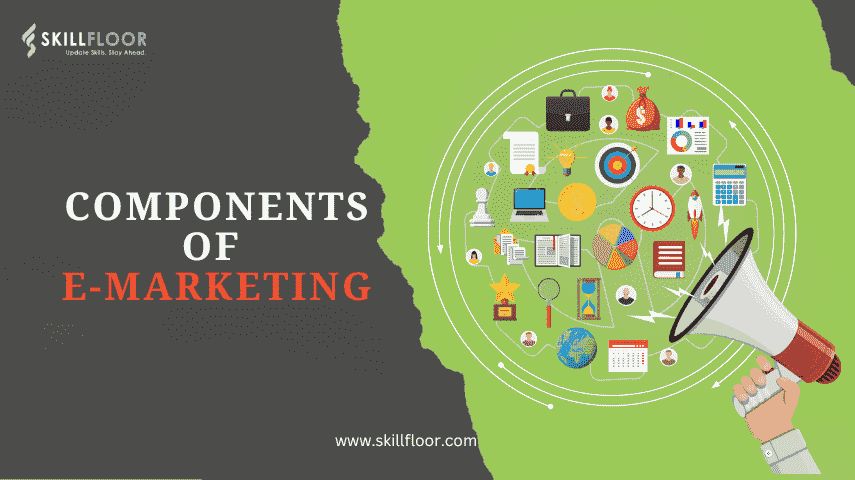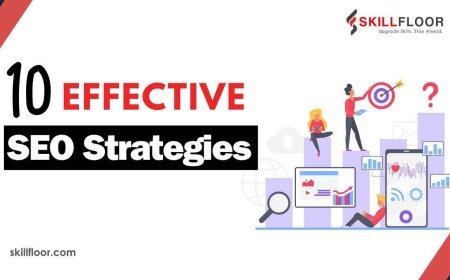Understanding the Components of E-Marketing
Learn the key components of e-marketing, including SEO, content, social media, PPC, and analytics, to build a successful online marketing strategy.

Mastering e-marketing is essential for anyone looking to succeed online. Whether you're launching a new product, building your brand, or getting traffic to your website, understanding the core elements of e-marketing can make a big difference., I'll explain the key parts of e-marketing, why they're important, and how I use them effectively. Let's break it down and explore each part together.
Implement Email Marketing Campaigns
You’re about to launch a new product and want to make sure it gets the attention it deserves. You might ask yourself: What steps should I take to ensure my online marketing is effective? How do I get all the different parts of my e-marketing strategy to work together seamlessly?
With digital marketing constantly changing, it’s important to have a clear and effective e-marketing plan. However, with so many different strategies and tools available, it can be overcome to know where to start and what to focus on.
Integrating E-Marketing Components
The challenge for many businesses, especially those new to digital marketing, is understanding how to integrate all the various components of an e-marketing strategy. It’s easy to become distracted by the latest trends or technologies without fully grasping how they should be used. This can result in a disjointed marketing approach that fails to deliver the desired results.
Additionally, the rapid pace of change in digital marketing tools and platforms can make it difficult to stay current with best practices. Without a clear understanding of how each component fits into your overall strategy, you might waste time and resources on tactics that don’t align with your goals.
So, how do you effectively over and utilize the different parts of e-marketing to build a peaceful and successful strategy?
Leveraging E-Marketing Components for a Robust Plan
To answer this question, let’s delve into each major component of e-marketing. I’ll explain what each one involves, why it’s important, and how to use it effectively to build a successful e-marketing strategy.

1. Content Marketing
Content marketing is about creating and sharing valuable, relevant content to attract and engage your target audience. This can include blog posts, articles, videos, infographics, podcasts, and more. The goal is to provide content that educates, entertains, or solves problems for your audience.
Why It’s Important: Quality content is crucial for building trust and authority with your audience. It also plays a significant role in improving your search engine rankings and driving organic traffic to your website.
Tips for Success:
-
Know Your Audience: Research and understand your audience’s needs, interests, and challenges. Tailor your content to address these aspects.
-
Create Valuable Content: Focus on providing information or entertainment that adds value to your audience’s experience. Aim to solve problems or answer questions they may have.
-
Be Consistent: Regularly publish new content to keep your audience engaged and coming back for more. Consistency helps build a loyal following.
Examples: A company that sells fitness equipment might create workout videos, nutrition tips, and blog posts about fitness trends to attract and engage fitness enthusiasts.
2. Search Engine Optimization (SEO)
SEO involves optimizing your online content to rank higher in search engine results pages (SERPs). This includes various techniques like keyword optimization, improving site structure, and building backlinks.
Why It’s Important: Higher rankings in search engine results increase your visibility and drive more organic traffic to your website. SEO is crucial for ensuring that your content is easily discoverable by people searching for related topics.
Tips for Success:
-
Keyword Research: Use tools to identify relevant keywords that your target audience is searching for. Integrate these keywords naturally into your content.
-
Optimize On-Page Elements: Ensure that your web pages are optimized with appropriate titles, meta descriptions, headers, and image alt text.
-
Build Quality Backlinks: Aim to earn backlinks from reputable and relevant websites. Backlinks help improve your site’s authority and search engine ranking.
Examples: If you run an online bookstore, optimizing for keywords like “best fiction books” or “book recommendations” can help attract readers searching for book-related content.
3. Email Marketing
Email marketing involves sending targeted messages to your audience through their email inbox. This can include newsletters, promotional offers, product updates, and personalized recommendations.
Why It’s Important: Email marketing allows you to communicate directly with your audience, fostering relationships and driving engagement. It’s an effective way to keep your audience informed and encourage repeat visits or purchases.
Tips for Success:
-
Segment Your Audience: Divide your email list into different segments based on interests, behavior, or demographics. Tailor your messages to each segment for better relevance.
-
Craft Compelling Subject Lines: Your subject line should grab attention and entice recipients to open your email. A strong subject line can significantly impact open rates.
-
Provide Value: Ensure that your emails offer something valuable, such as exclusive content, discounts, or useful information. Avoid sending irrelevant or overly promotional content.
Examples: An online fashion retailer might send personalized emails with fashion tips, exclusive discounts, or updates about new arrivals based on customer preferences.
4. Social Media Marketing
Social media marketing involves using platforms like Facebook, Instagram, Twitter, and LinkedIn to promote your brand, engage with your audience, and drive traffic to your website.
Why It’s Important: Social media provides a platform for real-time interaction with your audience. It’s an excellent way to build brand awareness, foster community, and drive traffic through engaging content and social sharing.
Tips for Success:
-
Choose the Right Platforms: Focus on social media platforms where your target audience is most active. Different platforms cater to different demographics and interests.
-
Engage Regularly: Post consistently and interact with your audience through comments, messages, and shares. Engagement helps build relationships and loyalty.
-
Analyze Performance: Use analytics tools to track your social media performance, including engagement rates, reach, and referral traffic. Adjust your strategy based on what’s working and what isn’t.
Examples: A restaurant might use Instagram to share photos of new menu items, Facebook to promote events, and Twitter to engage with customers in real time.
5. Pay-Per-Click Advertising (PPC)
PPC advertising involves placing ads on search engines or social media platforms where you pay a fee each time someone clicks on your ad. This includes platforms like Google Ads and Facebook Ads.
Why It’s Important: PPC advertising allows you to reach your target audience quickly and effectively. It’s particularly useful for driving traffic to specific pages, promoting products, or running time-sensitive campaigns.
Tips for Success:
-
Target the Right Audience: Use targeting options to reach specific demographics, interests, or behaviors. This ensures that your ads are seen by people who are more likely to be interested.
-
Create Effective Ads: Write clear and compelling ad copy that highlights your key messages and includes a strong call-to-action (CTA). Ensure that your ads lead to relevant and optimized landing pages.
-
Monitor and Adjust: Regularly review your PPC campaign performance and make adjustments based on the data. Optimize your ads and targeting to improve results.
Examples: A travel agency might use Google Ads to target people searching for vacation packages or use Facebook Ads to promote special offers to users interested in travel.
6. Analytics and Reporting
Analytics and reporting involve tracking and measuring the performance of your e-marketing activities. Tools like Google Analytics provide insights into website traffic, user behavior, and campaign effectiveness.
Why It’s Important: Analytics help you understand how well your marketing efforts are working. By analyzing data, you can identify what’s driving results and where improvements are needed.
Tips for Success:
-
Set Clear Goals: Define specific objectives for your marketing campaigns, such as increasing website traffic, boosting conversions, or growing your email list.
-
Track Key Metrics: Monitor important metrics such as website visits, bounce rates, conversion rates, and engagement. This helps you gauge the effectiveness of your efforts.
-
Use Data to Optimize: Use insights from your analytics to make data-driven decisions and optimize your marketing strategies. Regularly review your performance and adjust your approach as needed.
Examples: An e-commerce site might track metrics like cart abandonment rates and conversion rates to identify and address issues in the purchasing process.
7. Conversion Rate Optimization (CRO)
CRO focuses on improving the effectiveness of your website or landing pages to increase the number of visitors who take a desired action, such as making a purchase or signing up for a newsletter.
Why It’s Important: By enhancing your conversion rate, you can get more value from the traffic you already have, leading to higher sales and better ROI without increasing your marketing spend.
Tips for Success:
-
Test Different Elements: Use A/B testing to compare different versions of your web pages, such as different headlines, images, or CTAs. Determine which version performs better and implement those changes.
-
Improve User Experience: Make sure your website is easy to navigate, loads quickly, and provides a smooth user experience. A well-designed site can significantly impact conversion rates.
-
Gather User Feedback: Collect feedback from visitors to identify pain points and areas for improvement. Use this information to enhance your site and address user concerns.
Examples: An online subscription service might test different sign-up forms and landing page layouts to see which ones lead to more completed subscriptions.
Putting It All Together
Understanding each component of e-marketing is just the beginning. The real challenge is to integrate
these elements into a cohesive strategy that works together seamlessly. Here’s how to bring it all together:
-
Align Your Goals: Ensure that each component of your e-marketing strategy supports your overall objectives. For example, your content should help with SEO, and your email campaigns should complement your social media efforts.
-
Maintain Consistency: Use a consistent message and branding across all your marketing channels. This helps build a strong and recognizable brand presence.
-
Evaluate and Adjust: Continuously monitor the performance of your e-marketing efforts. Use data and insights to make informed adjustments and improvements to your strategy.
mastering the components of e-marketing involves understanding what each part does and how they work together. By focusing on content marketing, SEO, email marketing, social media, PPC, analytics, and CRO, you can create a comprehensive e-marketing strategy that drives results and supports your business goals.




























































